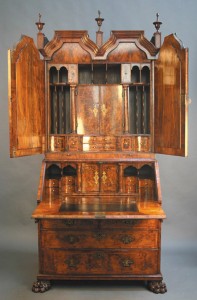
The famous Georgian furniture designer Thomas Sheraton in his Cabinet Dictionary of 1803 states that, in England, the term bureau has “generally been applied to common desks with drawers under them, such as are made very frequently in country towns.”
There is such delight in a bureau. As you open it, the fall flap opens downwards to form a writing surface. It reveals pigeonholes, drawers, a cupboard and sometimes even secret compartments. The sloping sides gather you as you sit at it, whether reading, working or just taking time to imagine.
There is nothing common or everyday about this William and Mary bureau bookcase. Veneered in the finest walnut, it formed part of a wonderful collection of 17th and 18th century furniture, which I auctioned as The Bolney Lodge Collection some years ago. Its elegant, tall proportions reflect the architectural fashion for higher ceilings as the 18th century approached. It has inlaid herringbone banding and the carved hairy paw feet are a lovely detail. The fine interior you see illustrated is enclosed by two arched doors, inset with exterior plate glass panels above candle slides. Candlelight reflected in mirrors like these is amplified in the most extraordinary way. It would have allowed the owner to use their bureau in comfort, even as the dark evenings drew in. Such fine examples continue to attract a strong collector’s premium and this one would realise in excess of £25,000 at auction today.
A good vernacular example from the 18th century, though, will still bring its owner a great deal of pleasure and can be purchased much more reasonably. Indeed, my own bureau is a typical example of this type. It lives in the corner of our spare room, a virtual study for our virtual age. It was made in England around 1770, during the reign of George III. As the world’s first industrial revolution gained its head of steam, a skilled country cabinetmaker set about making it. The drawer interiors are of cedar, the dovetails cut by hand. His eye was good and the proportions are just right. It is layered with prompts to fond memories; a family photograph, a drawer full of pebbles from a favourite beach, a little cupboard for my communion set, books and the odd sermon all vie for space with my tablet computer. Best of all, I can shut the flap on it all when I’ve done enough, or if Aunt Enid comes to stay!

The personal computer with its bulky boxes, screens, cables and keyboard could not be accommodated by the gracious bureau and values were undermined. After all, furniture is unusual among collectors’ fields in that it must not only be beautiful but also practical. Furniture must earn its space, especially in the modern home. The pleasures of a bureau, however, are finding renewed favour in our new wireless age of clouds, laptops and tablet PCs. They are once again proving to be the perfect home office and prices are set to rise. A good George III bureau in mahogany, like mine, can still be bought for about £300 at auction today. This bureau is almost two hundred and fifty years old, would grace any sitting room and is practical. It makes no demands on our world’s finite resources and will continue to be a pleasure to generations to come. Perhaps, in the end, antique furniture is green, not brown!
By Revd. Rupert Toovey. Originally published on 4th April 2013 in the West Sussex Gazette.